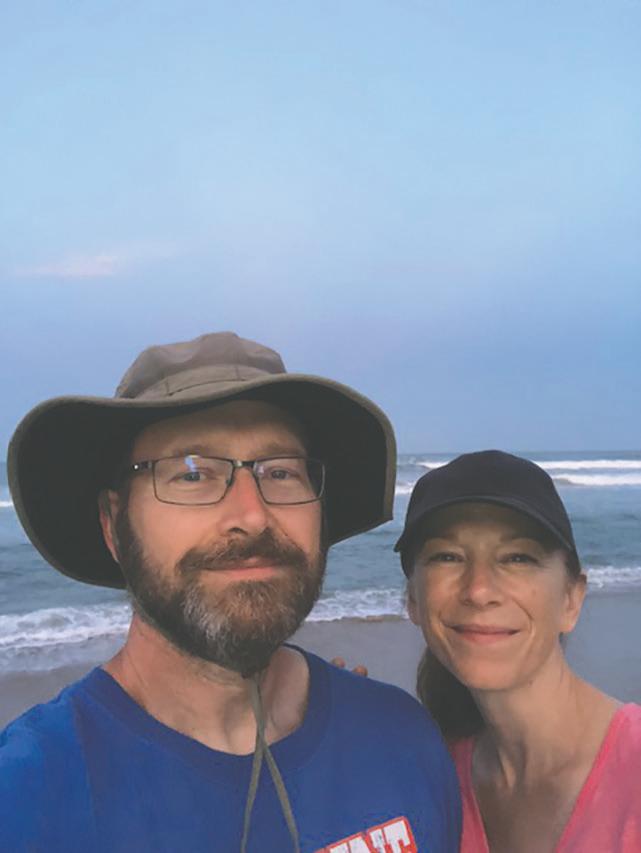
2 minute read
PERSEVERING
From page 2
On her 51st birthday, while making dinner, she received a phone call. The cancer had returned, but this time it was metastatic.
“I was now Stage 4,” Osborne said.
She yelled, screamed, and she and her husband wept, hand-inhand when she found out.
They spent time on the porch and watched the sunset, “experiencing this quiet, calming, quite unreasonable and miraculous peace,” she said.
A month and a half of procedures, tests, surgeries, new medication, radiation … it was a “cancer treatment whirlwind,” Osborne said.
As a result of that intense season, Osborne is pleased to still be here and doing well five years later.
Gratitude
“A surreal sort of everything-is-suddenly-put-in-perspective peace,” Osborne said, comes to her occasionally, reminding her of life’s preciousness and of her own mortality.
Osborne’s overwhelming gratitude is toward everyone who sent her gifts, text messages, emails, or talked to her throughout treatment and diagnosis. And even now, she reflects how her sister-in-law, a cancer survivor, described the abundance of gifts she received like “being bathed in love.”
“And I felt like I was immersed in a warm, tropical ocean of it,” Osborne said.
Full of gratitude toward her surgeons, Dr. Bollins, Dr. Boyle and Dr. Kubat, oncologist Dr. Silva-Benedict, radiation oncologist Dr. Arvold, support group facilitator Tina Roberts, and every nurse and staff member at St. Luke’s Cancer Care Center.
“I received the best and most compassionate care I could possibly have received,” Osborne said. “I continue to be so deeply grateful.”
LIFE NOW?
Osborne has regular visits with her oncologist and because of various treatments and medications, suffers from fatigue, intense hot flashes, joint pain and chronically low lymphocytes.
She allows herself times of feeling sadness and grief, and then moves on: toward joyful activities. She tries to serve people daily in big and small ways from housecleaning to mailing a card of encouragement, knowing how much it meant to her as the recipient.
Osborne continues to savor family time.

Chatting With A Breast Cancer Radiologist
Patients will meet Dr. Kerri Harting at St. Luke’s when they have an abnormal screen mammogram and didn’t know they had any breast changes, or if they feel or see something abnormal.
The majority of those with an abnormal mammogram don’t need a biopsy. Of the less than 10% of people who need a biopsy, only a small percentage have breast cancer.
The hardest part is the unknown.
“You’re in significant limbo,”
Harting said.
Once tests have begun, a patient is in the system which means the process can continue.
Persevering
From page 3
The Process
First, a technologist conducts the ultrasound or mammogram.
Next, a radiologist like Dr. Harting conducts the biopsy with the patient’s doctor’s orders, awaiting results from the pathologist. Harting interprets the findings and explains them to the patient.
Third, a nurse navigator, point of contact for patient and family, calls with the diagnosis and schedules surgery appointments, if cancer is found.
The breast center care team transitions the patient to the surgery care team.
The surgeon decides whether surgery or chemotherapy is best first. They often order additional testing to determine the cancer type. The surgeon and oncologist work together to develop a treatment plan.
Most Importantly
1. Trust that everyone on the care team is there to help. “Believe in the system,” Harting said, and don’t rely on the internet. With a highly communicative, comprehensive team at St. Lukes, the role of the nurse navigator is to help ensure that a patient isn’t lost in the cracks.
2. Let people help. When someone offers help, Harting urges her patients to take it. Women notoriously try to do it all on their own.
3. Stay positive. “There are wonderful treatment options now … (with) significant strides made in breast cancer treatment,” Harting said.
4. Start at 40. “It’s really important to get your mammograms every year,” Harting said.











